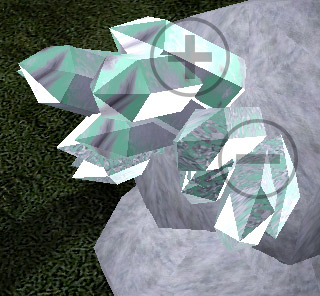Reason this Exists
This page was necessary, as we wanted to link to/show how to define crystals in multiple places, and it's a waste of effort to cut and paste changes both ways.
Here's The State of Things
There are a variety of attributes the ore crystals can have. The commonly accepted attributes right now are:- Color
- Pattern
- Shape
Note that even two identical-looking crystals may be different ores, or an ore and dirt or sand or limestone. (Previously theorized additional attributes are NOT sufficient to distinguish these, but it no longer matters thanks to Mineraology.) You may see designations with various other letters marking how long or how deeply set into the stones the crystals are, but these should be taken out of use.
Ideally, we would be able to stop using this system entirely, but even once all the old pages are converted/revised to use mineral names, there is no other way to tell apart the various varieties of dirt, limestone, and sand, and in many cases these must be known to tell what to look for to get gems when breaking the stones.
The effects of these attributes are discussed in Smelting Combinations and other pages listed at the top and bottom of this page. This is just a reference of what exists:
Colors and Patterns
- Color is commonly accepted as one of the most obvious attributes of a crystal. We are entirely sure that color matters.
- Patterns are commonly accepted as the other of the most obvious attributes of a crystal. We are entirely sure that pattern matters.
| Color | Mottled (M) | Spotted (S) | Cloud (C) | Black (B) |
| Aqua (A) |  |  | ||
| Green (G) |  |  |  | |
| Navy (N) |  |  |  |  |
| Pink (K) |  |  |  |
|
| Purple (P) |  |  |  |  |
| Red (R) |  |  |  |  |
| Sky (S) |  |  |  |  |
| Teal (T) |  |  |  |  |
| Yellow (Y) |  |  |  |  |
Shape
This is the shape of the tip of the crystal. This was the first attribute introduced after the obvious color and pattern attributes. It helped explain a lot of conflicting results we were having. The easiest way to see the shape of the crystal is by looking at the tip. The shape of the crystal is commonly accepted as important. The two known shapes are:
- +: wide/round/thick (All edges of the crystal itself are equal length -- producing an almost cylindrical (equilateral hexagon, really) crystal, when viewed from the tip)
- -: narrow/thin (Four of the edges of the crystal are SHORTER than the other two, making one dimension of the crystal distinctly longer, when viewed from the tip) (Very obviously *not* equilateral hexagon.One dimension is obviously more narrow than the other.)
Picture Note: The plus shape (+) is in teal cloud (TC) and the minus shape (-) is in teal spotted (TS). - MrBungle
